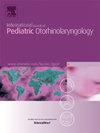Hearing and neurodevelopmental outcomes among children with congenital cytomegalovirus
IF 1.2
4区 医学
Q3 OTORHINOLARYNGOLOGY
International journal of pediatric otorhinolaryngology
Pub Date : 2025-05-26
DOI:10.1016/j.ijporl.2025.112408
引用次数: 0
Abstract
Objective
Congenital cytomegalovirus (cCMV) infection is the most common congenital infection and the leading non-genetic cause of sensorineural hearing loss. We assessed demographics, clinical characteristics, hearing and neurodevelopmental outcomes by 6 years of age among U.S. children with possible cCMV.
Study design
Retrospective cohort design.
Setting
The Audiological and Genetic Database (AudGenDB) includes 175,216 pediatric patients who underwent audiology, otology or genetic visits during 2006–2019 in Children's Hospital of Philadelphia, Vanderbilt Children's Hospital, or Boston Children's Hospital.
Methods
Children with possible cCMV were identified by diagnostic codes for cCMV infection and CMV disease up to 6 years of age. We examined clinical signs of cCMV during 0–45 days of birth and neurodevelopmental conditions (including hearing loss) up to 6 years of age. Hearing loss was defined as pure tone average or any frequency threshold ≥25 dB.
Results
A total of 180 (0.1 %) children with possible cCMV were identified; 70 % had diagnosis codes after 45 days of life. The proportions of Black and Hispanic/Latino children comprised a higher proportion in the possible cCMV group compared to the non-cCMV group. Overall, 129 (72 %) children with possible cCMV had diagnoses codes for neurodevelopmental conditions, including hearing loss (56), communication delays (45) and cerebral palsy (22). Hearing loss was diagnosed at a median age of 2 (1–4) years.
Conclusion
Neurodevelopmental delays were common among children with possible cCMV included in this study. AudGenDB provides access to longitudinal outcomes for a large and diverse cohort that remains helpful in lieu of state-mandated screenings.
先天性巨细胞病毒患儿的听力和神经发育结局
目的生殖巨细胞病毒(cCMV)感染是最常见的先天性感染,也是引起感音神经性听力损失的主要非遗传性原因。我们评估了美国可能患有cCMV的儿童6岁前的人口统计学、临床特征、听力和神经发育结局。研究设计回顾性队列设计。听力学和遗传数据库(AudGenDB)包括2006-2019年期间在费城儿童医院、范德比尔特儿童医院或波士顿儿童医院接受听力学、耳科或遗传就诊的175216名儿科患者。方法采用cCMV感染诊断代码和CMV疾病诊断代码对6岁以下可能存在cCMV的儿童进行鉴定。我们检查了出生0-45天cCMV的临床症状和6岁前的神经发育状况(包括听力损失)。听力损失定义为纯音平均或任何频率阈值≥25 dB。结果共检出可能为cCMV的患儿180例(0.1%);70%的患者在45天后有诊断代码。与非cCMV组相比,黑人和西班牙裔/拉丁裔儿童在可能的cCMV组中所占比例更高。总体而言,129名(72%)可能患有cCMV的儿童被诊断为神经发育状况,包括听力损失(56名)、沟通迟缓(45名)和脑瘫(22名)。听力损失的诊断中位年龄为2(1-4)岁。结论神经发育迟缓在本研究中可能的cCMV患儿中很常见。AudGenDB为一个大而多样的队列提供了纵向结果的访问,这仍然有助于代替国家强制筛查。
本文章由计算机程序翻译,如有差异,请以英文原文为准。
求助全文
约1分钟内获得全文
求助全文
来源期刊
CiteScore
3.20
自引率
6.70%
发文量
276
审稿时长
62 days
期刊介绍:
The purpose of the International Journal of Pediatric Otorhinolaryngology is to concentrate and disseminate information concerning prevention, cure and care of otorhinolaryngological disorders in infants and children due to developmental, degenerative, infectious, neoplastic, traumatic, social, psychiatric and economic causes. The Journal provides a medium for clinical and basic contributions in all of the areas of pediatric otorhinolaryngology. This includes medical and surgical otology, bronchoesophagology, laryngology, rhinology, diseases of the head and neck, and disorders of communication, including voice, speech and language disorders.

 求助内容:
求助内容: 应助结果提醒方式:
应助结果提醒方式:


